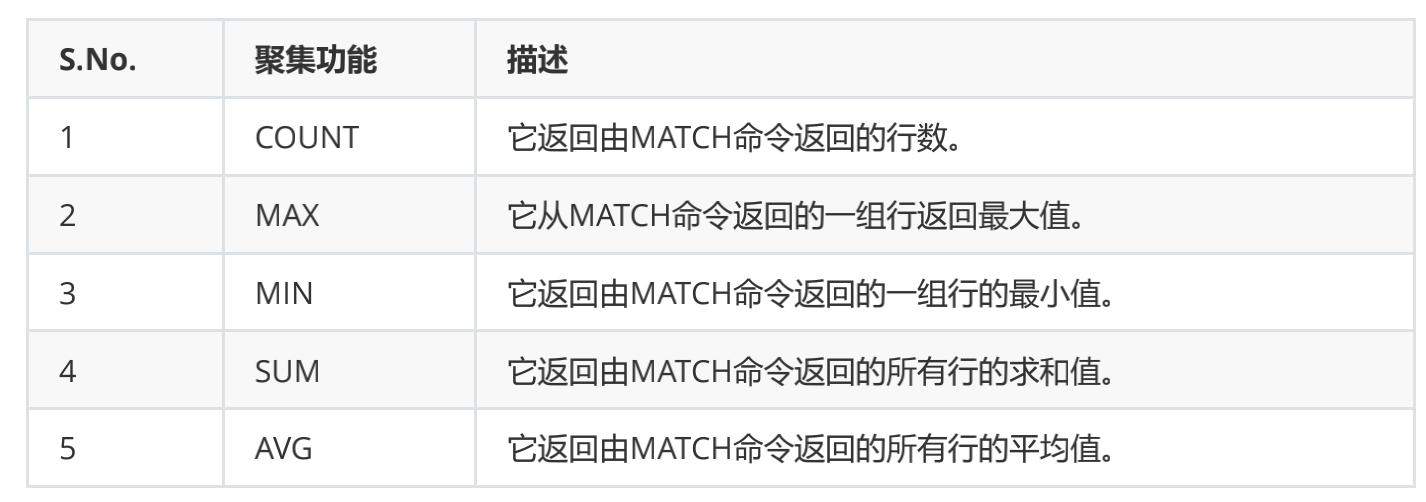Neo4j高级应用
1. CQL函数
1.1 字符串函数

MATCH (p:Person) RETURN ID(p),LOWER(p.character)match(p:Person) return p.character,lower(p.character),p.name,substring(p.name,2),replace(p.name,"子","z i")1.2 聚合函数

MATCH (p:Person) RETURN MAX(p.money),SUM(p.money)1.3 关系函数

match p = (:Person {name:"林婉儿"})-[r:Couple]-(:Person)
RETURN STARTNODE(r)1.4 shortestPath函数返回最短的path
MATCH p=shortestPath((node1)-[*]-(node2)) RETURN length(p), nodes(p)MATCH p=shortestPath((person:Person {name:"王启年"})-[*]-(person2:Person {name:"九品射手燕小乙"})) RETURN length(p), nodes(p)2 CQL多深度关系节点
1.使用with关键字
查询三层级关系节点如下:with可以将前面查询结果作为后面查询条件match (na:Person)-[re]->(nb:Person) where na.name="范闲" WITH na,re,nb match (nb:Person)-
[re2]->(nc:Person) return na,re,nb,re2,nc
match (na:Person)-[re]->(nb:Person) where na.name="林婉儿" WITH na,re,nb match (nb:Person)-
[re2]->(nc:Person) return na,re,nb,re2,nc
match (na:Person)-[re]-(nb:Person) where na.name="林婉儿" WITH na,re,nb match (nb:Person)-
[re2]->(nc:Person) return na,re,nb,re2,nc
match (na:Person)-[re]-(nb:Person) where na.name="林婉儿" WITH na,re,nb match (nb:Person)-
[re2:Friends]->(nc:Person) return na,re,nb,re2,nc
2.直接拼接关系节点查询match (na:Person{name:"范闲"})-[re]->(nb:Person)-[re2]->(nc:Person) return na,re,nb,re2,nc
为了方便,可以将查询结果赋给变量,然后返回match data=(na:Person{name:"范闲"})-[re]->(nb:Person)-[re2]->(nc:Person) return data
3.使用深度运算符
当实现多深度关系节点查询时,显然使用以上方式比较繁琐。
可变数量的关系->节点可以使用-[:TYPEminHops..maxHops]-。
查询:
match data=(na:Person{name:”范闲”})-[1..2]-(nb:Person) return data
3. 事务
为了保持数据的完整性和保证良好的事务行为,Neo4j也支持ACID特性 。
注意:
(1)所有对Neo4j数据库的数据修改操作都必须封装在事务里。
(2)默认的isolation level是READ_COMMITTED。
(3)死锁保护已经内置到核心事务管理 。 (Neo4j会在死锁发生之前检测死锁并抛出异常。在异常抛出之 前,事务会被标志为回滚。当事务结束时,事务会释放它所持有的锁,则该事务的锁所引起的死锁也就是解 除,其他事务就可以继续执行。当用户需要时,抛出异常的事务可以尝试重新执行)
(4)除特别说明,Neo4j的API的操作都是线程安全的,Neo4j数据库的操作也就没有必要使用外部的同步方 法。4.索引
4.1 简介
Neo4j CQL支持节点或关系属性上的索引,以提高应用程序的性能。
可以为具有相同标签名称的属性上创建索引。
可以在MATCH或WHERE等运算符上使用这些索引列来改进CQL的执行。
4.2 创建单一索引
CREATE INDEX ON :Label(property)
例如:CREATE INDEX ON :Person(name)
4.3 创建复合索引
CREATE INDEX ON :Person(age, gender)
4.4 全文模式索引
之前的常规模式索引只能对字符串进行精确匹配或者前后缀索引(startswith,endswith,contains),全文索引将标记化索引字符串值,因此它可以匹配字符串中任何位置的术语。索引字符串如何被标记化并分解为术语,取决于配置全文模式索引的分析器。索引是通过属性来创建,便于快速查找节点或者关系。
创建和配置全文模式索引
使用db.index.fulltext.createNodeIndex和db.index.fulltext.createRelationshipIndex创建全文模式索引。在创建索引时,每个索引必须为每个索引指定一个唯一的名称,用于在查询或删除索引时引用相关的特定索引。然后,全文模式索引分别应用于标签列表或关系类型列表,分别用于节点和关系索引,然后应用于属性名称列表。
call db.index.fulltext.createNodeIndex("索引名",[Label,Label],[属性,属性])
call db.index.fulltext.createNodeIndex("nameAndDescription",["Person"],["name", "description"])
call db.index.fulltext.queryNodes("nameAndDescription", "范闲") YIELD node, score RETURN node.name, node.description, score4.5 查看和删除索引
call db.indexes或者:schema
DROP INDEX ON :Person(name)
DROP INDEX ON :Person(age, gender)
call db.index.fulltext.drop("nameAndDescription")
5. 约束
5.1 唯一性约束
作用
避免重复记录。
强制执行数据完整性规则
创建唯一性约束CREATE CONSTRAINT ON (变量:<label_name>) ASSERT变量.<property_name> IS UNIQUE
具体实例:CREATE CONSTRAINT ON (person:Person) ASSERT person.name IS UNIQUE
删除唯一性约束DROP CONSTRAINT ON (cc:Person) ASSERT cc.name IS UNIQUE
5.2 属性存在约束(企业版中可用)
CREATE CONSTRAINT ON (p:Person) ASSERT exists(p.name)5.3 查看约束
call db.constraints :schema6. Neo4j之Admin管理员操作
6.1 Neo4j-数据库备份和恢复
在对Neo4j数据进行备份、还原、迁移的操作时,首先要关闭neo4j
./bin/neo4j stop数据备份到文件
./bin/neo4j-admin dump --database=graph.db --to=/root/qyn.dump还原、迁移之前 ,关闭neo4j服务。操作同上
./bin/neo4j-admin load --from=/root/qyn.dump --database=graph.db --force重启服务
./bin/neo4j start注意,运行数据备份可能会警告
WARNING: Max 1024 open fifiles allowed, minimum of 40000 recommended. See the Neo4j manual
1.编辑这个文件
vi /etc/security/limits.conf
在文件最后加入下面这段 修改最大打开文件限制
* soft nofile 65535
* hard nofile 655352.重启服务器
再次执行上面的步骤 警告就没有了
6.2 调优思路
1.增加服务器内存 和 调整neo4j配置文件
# java heap 初始值
dbms.memory.heap.initial_size=1g
# java heap 最大值,一般不要超过可用物理内存的80%
dbms.memory.heap.max_size=16g
# pagecache大小,官方建议设为:(总内存-dbms.memory.heap.max_size)/2,
dbms.memory.pagecache.size=2g2.neo4j刚启动数据是冷的需要预热
MATCH (n)
OPTIONAL MATCH (n)-[r]->()
RETURN count(n.name) + count(r);3.查看执行计划进行索引优化
Cypher查询计划程序将每个查询转换为执行计划。 执行计划告诉Neo4j在执行查询时要执行哪些操作。
对执行计划的生成,Neo4j使用的都是基于成本的优化器(Cost Based Optimizer,CBO),用于制订精确的执行过程。可以采用如下两种不同的方式了解其内部的工作机制:
EXPLAIN:是解释机制,加入该关键字的Cypher语句可以预览执行的过程但并不实际执行,所以也不会产生任何结果。
PROFILE:则是画像机制,查询中使用该关键字,不仅能够看到执行计划的详细内容,也可以看到查询的执行结果。
关注指标:
estimated rows: 需要被扫描行数的预估值
dbhits: 实际运行结果的命中绩效
两个值都是越小越好使用索引和不使用索引对比MATCH (p { name : '范闲' }) RETURN p
在之前加上profifile来进行查询,可以查看查询计划
7. Neo4j数据访问
7.1 Neo4j访问的两种方式
- 嵌入式数据库
- 服务器模式(通过REST的访问)
它是由应用程序的性质(neo4j是独立服务器 还是和程序在一起),性能,监控和数据安全性来决定架构
选择。
(1)An embedded database(嵌入式数据库)
嵌入式Neo4j数据库是性能的最佳选择。 通过指定数据存储的路径以编程方式访问嵌入式数据库。
我们选择嵌入式数据库出于以下原因:
- 使用Java作为我们项目的编程语言时
- 应用程序是独立的
- 程序追求很高的性能
(2)Neo4j Server(服务器模式)
Neo4j Server是相互操作性,安全性和监控的最佳选择。 实际上,REST接口允许所有现代平台和编程 语言与它进行互操作。 此外,作为独立应用程序,它比嵌入式配置更安全(客户端中的潜在故障不会影响服务器),并且更易于监控。 如果我们选择使用这种模式,我们的应用程序将充当Neo4j服务器的客户端。要连接到Neo4j服务器,可以使用任何编程语言的REST 访问数据库。
7.2 Java客户端操作Neo4j
1.嵌入式模式
<dependency>
<groupId>org.neo4j</groupId>
<artifactId>neo4j</artifactId>
<version>3.5.5</version>
</dependency>package org.example;
import org.neo4j.graphdb.GraphDatabaseService;
import org.neo4j.graphdb.Label;
import org.neo4j.graphdb.Node;
import org.neo4j.graphdb.Transaction;
import org.neo4j.graphdb.factory.GraphDatabaseFactory;
import java.io.File;
/**
* Hello world!
*
*/
public class App
{
private static final File DATABASE_DIRECTORY = new File("target/graph.db");
public static void main( String[] args )
{
//创建数据库服务对象
GraphDatabaseService graphDatabaseService = new GraphDatabaseFactory().newEmbeddedDatabase(DATABASE_DIRECTORY);
System.out.println("database load!");
//获取事务对象 开启事务
Transaction tx = graphDatabaseService.beginTx();
Node n1 = graphDatabaseService.createNode();
n1.setProperty("name", "zhangsan");
n1.setProperty("age", 23);
n1.setProperty("money", 1234);
n1.setProperty("character", 'A');
n1.addLabel(new Label() {
@Override
public String name() {
return "Person";
}
});
//定义CQL
String cql = "CREATE(p:Person {name:'李四', character:'B',money:2334})";
graphDatabaseService.execute(cql);
tx.success();
tx.close();
graphDatabaseService.shutdown();
System.out.println( "Hello World! shutdown" );
}
}
package org.example;
import org.neo4j.cypher.internal.v3_5.ast.Where;
import org.neo4j.graphdb.*;
import org.neo4j.graphdb.factory.GraphDatabaseFactory;
import java.io.File;
import java.util.HashMap;
import java.util.Map;
/**
* @author :xjlonly
* @date :Created in 2021/5/17 10:31
* @description:
* @modified By:
* @version: $
*/
public class EmbeddedNeo4jQueryAll {
private static final File DATABASE_DIRECTORY = new File("target/graph.db");
public static void main(String[] args) {
//创建数据库服务对象
GraphDatabaseService graphDatabaseService = new GraphDatabaseFactory().newEmbeddedDatabase(DATABASE_DIRECTORY);
System.out.println("database load!");
//定义CQL
String cql = "MATCH(p:Person) where p.money <$money return p";
Map<String,Object> stringObjectMap = new HashMap<>();
stringObjectMap.put("money",25000);
//获取事务对象 开启事务
Transaction tx = graphDatabaseService.beginTx();
final Result result = graphDatabaseService.execute(cql, stringObjectMap);
while (result.hasNext()){
Map<String,Object> row = result.next();
for(String key : result.columns()){
Node nd = (Node)row.get(key);
System.out.printf("%s=%s:%s%n", key, nd.getProperties("name"), nd.getProperties("money"));
}
}
tx.success();
tx.close();
graphDatabaseService.shutdown();
System.out.println( "Hello World! shutdown" );
}
}
2.服务器模式
<dependency>
<groupId>org.neo4j</groupId>
<artifactId>neo4j-ogm-bolt-driver</artifactId>
<version>3.2.10</version>
</dependency>package org.example;
import org.neo4j.driver.*;
/**
* Hello world!
*
*/
public class App
{
public static void main( String[] args )
{
Driver driver = GraphDatabase.driver("bolt://192.168.2.118:7687", AuthTokens.basic("neo4j", "123456"));
//获取会话对象
final Session session = driver.session();
String cql = "MATCH(p:Person) WHERE p.money>$money return p.money AS money, p.name AS name order by p.money";
final Result result = session.run(cql, Values.parameters("money", 1000));
while ( result.hasNext() ) {
Record record = result.next();
System.out.println( record.get( "name" ).asString() + " " + record.get( "money" ).asDouble() ); }
System.out.println( "Hello World!" );
}
}
package org.example;
import org.neo4j.driver.*;
/**
* Hello world!
*
*/
public class App
{
public static void main( String[] args )
{
Driver driver = GraphDatabase.driver("bolt://192.168.2.118:7687", AuthTokens.basic("neo4j", "123456"));
//获取会话对象
final Session session = driver.session();
// String cql = "MATCH(p:Person) WHERE p.money>$money return p.money AS money, p.name AS name order by p.money";
// final Result result = session.run(cql, Values.parameters("money", 1000));
// while ( result.hasNext() ) {
// Record record = result.next();
// System.out.println( record.get( "name" ).asString() + " " + record.get( "money" ).asDouble() ); }
//
String cql = "MATCH p=shortestPath((person:Person {name:$startName})-[*]-(person2:Person {name:$endName})) RETURN p";
final Result result = session.run( cql, Values.parameters("startName","王启年","endName","九品射手燕小乙") );
while (result.hasNext()) {
Record record = result.next();
System.out.println(record);
}
System.out.println( "Hello World!" );
}
}
7.3 SpringBoot 整合Neo4j

1.导入jar包
<?xml version="1.0" encoding="UTF-8"?>
<project xmlns="http://maven.apache.org/POM/4.0.0" xmlns:xsi="http://www.w3.org/2001/XMLSchema-instance"
xsi:schemaLocation="http://maven.apache.org/POM/4.0.0 http://maven.apache.org/xsd/maven-4.0.0.xsd">
<parent>
<groupId>org.springframework.boot</groupId>
<artifactId>spring-boot-starter-parent</artifactId>
<version>2.0.5.RELEASE</version>
</parent>
<modelVersion>4.0.0</modelVersion>
<artifactId>spring-boot-neo4j-demo</artifactId>
<name>spring-boot-neo4j-demo</name>
<!-- FIXME change it to the project's website -->
<url>http://www.example.com</url>
<properties>
<project.build.sourceEncoding>UTF-8</project.build.sourceEncoding>
<maven.compiler.source>11</maven.compiler.source>
<maven.compiler.target>11</maven.compiler.target>
</properties>
<dependencies>
<dependency>
<groupId>junit</groupId>
<artifactId>junit</artifactId>
<version>4.12</version>
<scope>test</scope>
</dependency>
<dependency>
<groupId>org.springframework.boot</groupId>
<artifactId>spring-boot-starter-data-neo4j</artifactId>
</dependency>
<dependency>
<groupId>org.neo4j</groupId>
<artifactId>neo4j-ogm-bolt-driver</artifactId>
</dependency>
</dependencies>
<build>
<pluginManagement><!-- lock down plugins versions to avoid using Maven defaults (may be moved to parent pom) -->
<plugins>
<!-- clean lifecycle, see https://maven.apache.org/ref/current/maven-core/lifecycles.html#clean_Lifecycle -->
<plugin>
<groupId>org.springframework.boot</groupId>
<artifactId>spring-boot-maven-plugin</artifactId> </plugin>
</plugins>
</pluginManagement>
</build>
</project>
2.建立实体类
package org.example.pojo;
import org.neo4j.ogm.annotation.*;
import java.util.Set;
/**
* @author :xjlonly
* @date :Created in 2021/5/17 10:59
* @description:
* @modified By:
* @version: $
*/
@NodeEntity
public class Person {
@Id
@GeneratedValue
private Long id;
@Property("cid")
private int pid;
@Property
private String name;
private String character;
private double money;
private int gender;
private int age;
private String description;
public Person() {
}
@Relationship(type = "Friends",direction = Relationship.INCOMING)
private Set<Person> relationPersons;
public Long getId() {
return id;
}
public void setId(Long id) {
this.id = id;
}
public int getPid() {
return pid;
}
public void setPid(int pid) {
this.pid = pid;
}
public String getName() {
return name;
}
public void setName(String name) {
this.name = name;
}
public String getCharacter() {
return character;
}
public void setCharacter(String character) {
this.character = character;
}
public double getMoney() {
return money;
}
public void setMoney(double money) {
this.money = money;
}
public int getGender() {
return gender;
}
public void setGender(int gender) {
this.gender = gender;
}
public int getAge() {
return age;
}
public void setAge(int age) {
this.age = age;
}
public String getDescription() {
return description;
}
public void setDescription(String description) {
this.description = description;
}
public Set<Person> getRelationPersons() {
return relationPersons;
}
public void setRelationPersons(Set<Person> relationPersons) {
this.relationPersons = relationPersons;
}
@Override
public String toString() {
return "Person{" +
"id=" + id +
", pid=" + pid +
", name='" + name + '\'' +
", character='" + character + '\'' +
", money=" + money +
", gender=" + gender +
", age=" + age +
", description='" + description + '\'' +
", relationPersons=" + relationPersons +
'}';
}
public Person(Long id, int pid, String name, String character, double money, int gender, int age, String description, Set<Person> relationPersons) {
this.id = id;
this.pid = pid;
this.name = name;
this.character = character;
this.money = money;
this.gender = gender;
this.age = age;
this.description = description;
this.relationPersons = relationPersons;
}
}
3.数据持久化类
package org.example.repository;
import org.example.pojo.Person;
import org.springframework.data.neo4j.annotation.Query;
import org.springframework.data.neo4j.repository.Neo4jRepository;
import org.springframework.data.repository.query.Param;
import org.springframework.stereotype.Repository;
import java.util.List;
/**
* @author :xjlonly
* @date :Created in 2021/5/17 11:04
* @description:
* @modified By:
* @version: $
*/
@Repository
public interface PersonRepository extends Neo4jRepository<Person, Long> {
@Query("match(p:Person) where p.money > {0} return p")
List<Person> personList(double money);
@Query("MATCH p=shortestPath((person:Person {name:{0}})-[*1..4]- (person2:Person {name:{1}}) ) RETURN p")
List<Person> shortestPath(String startName, String endName);
// @Query("match(p:Person) where p.money>{money} return p")
// List<Person> personList(@Param("money") double money);
// /** 指定开始的名字 和 结束的名字 查询最短路径 限定深度为4以层包含4*/
// @Query("match p=shortestPath((person:Person{name:{startName}})-[*1..4]- (person2:Person {name:{endName}})) return p")
// List<Person> shortestPath(@Param("startName") String startName,@Param("endName") String endName);
}
4. 配置文件 application.yml
spring:
data:
neo4j:
username: neo4j
password: 123456
uri: bolt://192.168.2.118:7687
#uri: http://192.168.2.118:7474
#uri: file:///target/graph.db5.编写服务类
package org.example.service;
import org.example.pojo.Person;
import org.example.repository.PersonRepository;
import org.springframework.beans.factory.annotation.Autowired;
import org.springframework.stereotype.Service;
import java.util.ArrayList;
import java.util.List;
/**
* @author :xjlonly
* @date :Created in 2021/5/17 11:06
* @description:
* @modified By:
* @version: $
*/
@Service("personService")
public class Neo4jPersonService {
@Autowired
private PersonRepository personRepository;
public List<Person> getAll(){
List<Person> datas = new ArrayList<>();
personRepository.findAll().forEach(x->datas.add(x));
return datas;
}
public Person save(Person person){
return personRepository.save(person);
}
public List<Person> personList(double money){
return personRepository.personList(money);
}
public List<Person> shortestPath(String startName, String endName){
return personRepository.shortestPath(startName,endName);
}
}
6.编写测试类
package org.example;
import org.example.pojo.Person;
import org.example.service.Neo4jPersonService;
import org.springframework.boot.SpringApplication;
import org.springframework.boot.autoconfigure.SpringBootApplication;
import org.springframework.context.ApplicationContext;
import org.springframework.context.ConfigurableApplicationContext;
import java.util.List;
/**
* Hello world!
*
*/
@SpringBootApplication
public class App
{
public static void main( String[] args )
{
final ApplicationContext context = SpringApplication.run(App.class, args);
final Neo4jPersonService personService = context.getBean(Neo4jPersonService.class);
// Person person = new Person();
// person.setName("王五");
// person.setMoney(23444);
// person.setAge(34);
// person.setCharacter("C");
// final Person save = personService.save(person);
// System.out.println(save);
List<Person> datas = personService.personList(1000);
System.out.println(datas);
System.out.println(personService.shortestPath("王启年", "九品射手燕小乙"));
}
}










